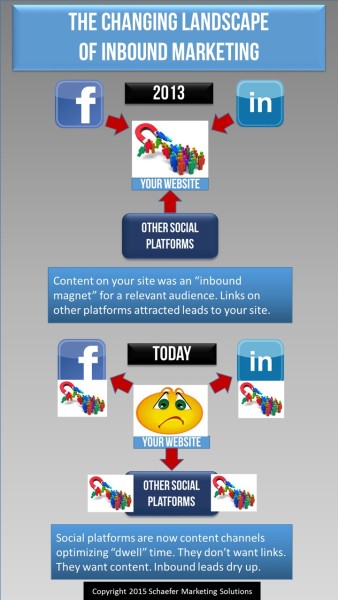
Every time I write a post that takes a slightly contrarian view to the status quo, I get hammered by the entrenched pundits who spin this into “Mark is saying that marketing is dead”… or social media is dead … Or that kittens are bad. You get the point.
Today I am going to point out a THREAT to inbound marketing to make you think about what we have considered traditional dynamics of inbound marketing in a new way. I am not saying anything is dead. Really.
Let’s take a look at some of the current marketing trends and how they might make inbound marketing much more difficult in the future.
The goal of inbound marketing
Inbound marketing is a term coined by Brian Halligan of HubSpot to describe a way to promote a company through blogs, podcasts, video, eBooks, newsletters, social media marketing, and other forms of content marketing which serve to attract customers.
Inbound marketing refers to marketing activities that bring high-potential visitors in, rather than relying on sales people having to make cold calls to garner “outbound” leads. Inbound marketing earns the attention of customers, makes the company easy to be found, and draws customers to your website like a magnet.
Hubspot tends to view inbound marketing as an engine for leads. I tend to view Inbound marketing as an engine for relationships. But in the end, the goal is the same — sales.
Inbound marketing is art and science, and done well it works really well. Because it’s so effective, most brands are spending dramatically more on content marketing, creating overwhelming information density in thier niches (or Content Shock), but that is another story.
The game is changing
The economics of the social media platforms like Facebook and LinkedIn are also driven by content, but their metrics are different. They’re not trying to generate leads for a discrete product. They are trying to:
a) Collect more personal information about you so…
b) They can charge advertisers for targeted display ads.
The economic driver for both of these priorities is time on site, also known as dwell time, which is becoming a factor in SEO, Facebook content visibility, and content marketing strategy. The more time you spend consuming a piece of content, the more information is collected and the more ads you can see.
A few years ago, the major social platforms were happy to have your links to great content but now they are transforming themselves into virtual news and entertainment channels because they want you to spend time on their site, not yours.
For example the Facebook content strategy now includes a video viewer to keep people on their newsfeed they are wooing major content channels to publish directly on their site. LinkedIn has become a significant content publishing platform featuring some of the biggest names in business.
No content creator should be happy about this development but the biggest channels may get a cut of the action. Facebook has proposed hosting content from the New York Times, National Geographic, Buzzfeed, and other major news sites and involving them in a revenue-sharing deal. (Here is a prediction: Facebook will eventually begin to acquire content sites and produce their own original content like Netflix).
The implications
So if you’re not The New York Times or Buzzfeed and can’t expect to make money from posting content directly to Facebook, what do these trends mean for you?
If you have been counting on Facebook, LinkedIn and other platforms as a primary distribution strategy for your content links, increasingly, the best way to gain exposure in those places is to actually post the full-form “sticky content” on those sites to achieve massive dwell time. This is probably the best strategy to at least achieve exposure for your content through organic reach.
The option that seems to be developing is, post the full-form content or get relegated to the dustbin. And that means those posts are NOT driving people to your website like the good old link used to do. The inbound traffic is now headed away from you, to Facebook and LinkedIn, instead of the homebase. Now the content magnet is on Facebook instead of your site where you have all those dandy calls to action.
What’s a marketer to do? I don’t have all the answers. That’s why I have a comment section and a community of super-smart people. Let me know your thought on this, won’t you?
Something free for you! If you would like to download a copy of the infographic from today’s post as a full-size image to use in your own blog or presentation click here: The changing landscape of inbound marketing graphic (vertical) or The changing landscape of inbound marketing (horizontal). Please provide a professional level of attribution.